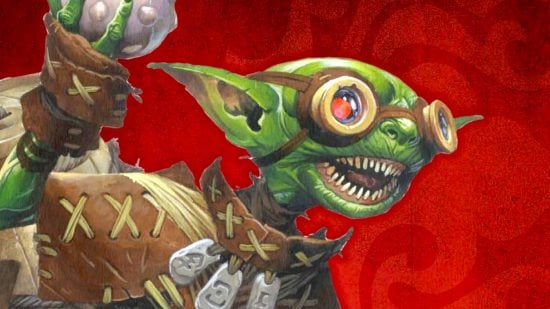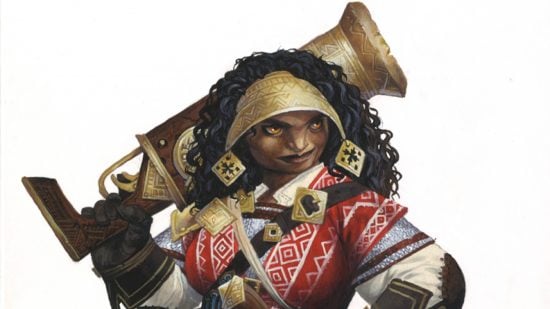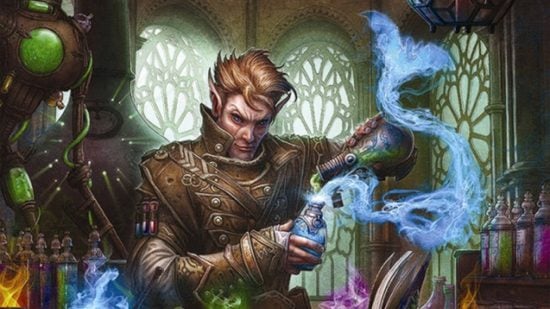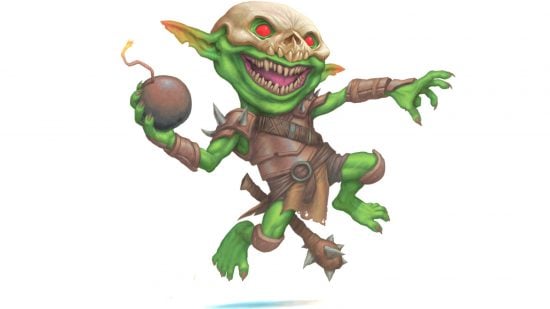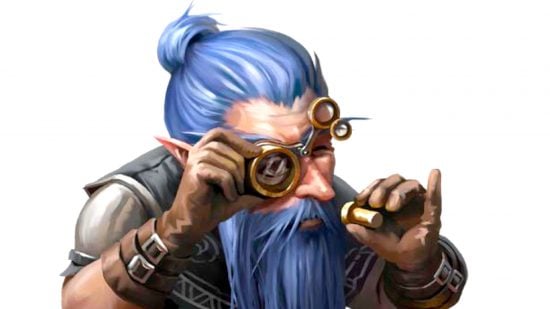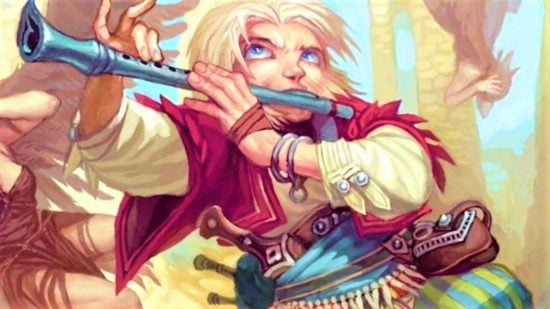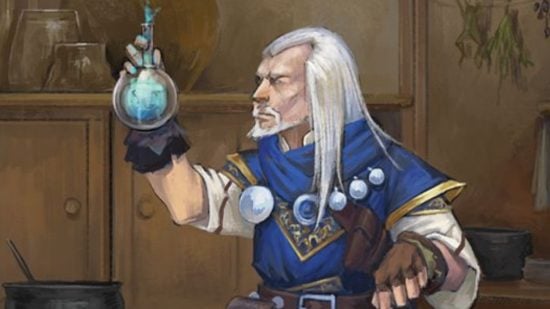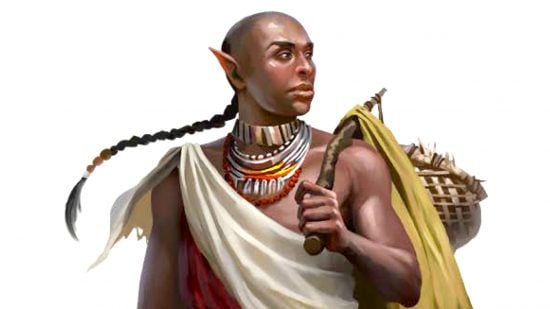With the rapid expansion of Paizo’s Pathfinder fantasy universe since the TTRPG’s first edition came out in 2009, it’s spawned a vast range of Pathfinder races – called ‘ancestries’ – to choose from. Ranging from the simple Gnome and Elf to playable Kobold, Gargoyle, and Android races, the full list is nearing 40 (and that’s just in second edition). Our guide will start by detailing the core six Pathfinder 2e races, their lore, and key stats.
As a thoroughbred tabletop RPG, originally built from the bones of third edition Dungeons and Dragons, Pathfinder has some crossover with the classic DnD races you may know. It also has a character class system to design the role you’ll play in your party – for help there, try our full Pathfinder classes guide. You’ll find some similarities to the DnD classes if you’re already familiar with these, but there are plenty of key differences to understand.
That’s enough about the differences between Pathfinder and DnD though. Let’s talk 2e ancestries.
These are the core, playable Pathfinder 2e races:
Naturally, for a TTRPG as beloved, mature, and expansive as Pathfinder 2e, there are a lot of other playable races besides those core six ancestries – 30 of them, by our reckoning (plus six more that will be found in an as-yet-unreleased Pathfinder book). It’ll take us time to do proper deep dives into every single one, but, for the moment, here’s a table of the lot.
Here are all the playable Pathfinder races:
| Core races | Uncommon races | Rare races |
| Dwarf | Azarketi | Anadi |
| Elf | Catfolk | Android |
| Goblin | Fetchling | Automaton |
| Gnome | Gnoll | Conrasu |
| Halfling | Grippli | Fleshwrap |
| Human | Hobgoblin | Ghoran |
| – | Kitsune | Goloma |
| – | Kobold | Kashrishi |
| – | Leshy | Poppet |
| – | Lizardfolk | Shisk |
| – | Nagaji | Shoony |
| – | Orc | Skeleton |
| – | Ratfolk | Sprite |
| – | Tengu | Strix |
| – | Vanara | Vishkanya |
Not included in this list are six of the most recently announced ancestries: Merfolk, Athamarus, Surkis, and awakened animals, plus the Minotaur and the Centaur. These mythology-inspired races appear in Howl of the Wild, a Pathfinder book that’s set to release in 2024.
Pathfinder Dwarf
The Pathfinder Dwarf race is fairly close to the classic Tolkien variety we know and love; the Pathfinder 2e Core Rulebook describes them as “a stoic and stern people, ensconced within citadels and cities carved from solid rock”; it says they’re “short and stocky” folk who’re “slow to trust those outside their kin”.
“If you want to play a character who is as hard as nails, a stubborn and unrelenting adventurer, with a mix of rugged toughness and deep wisdom—or at least dogged conviction,” it says, “you should play a Dwarf.”
The core Pathfinder Dwarf stats are:
| Stat | Value |
| Hit points | 10 |
| Size | Medium |
| Speed | 20 feet |
| Ability boosts |
|
| Ability flaw | Charisma |
| Languages |
|
| Traits |
|
| Darkvision | You can see in darkness just as well as bright light – but your vision is monochrome |
| Clan Dagger | You get one free Clan Dagger item – but selling it will bring disdain from other Dwarves due to taboo |
Pathfinder Elf
The Pathfinder Elf race also borrows much from J.R.R. Tolkien’s elves – and the DnD Elf 5e and Half-elf 5e races based on them.
“Elves combine otherworldly grace, sharp intellect, and mysterious charm in a way that is practically magnetic to members of other ancestries,” says the Pathfinder 2e Core Rulebook. They’re an incredibly long-lived and “often rather private people”, it adds, with “the perspective that can come only from watching the arc of history”.
“Their inborn patience and intellectual curiosity make elves excellent sages, philosophers, and wizards, and their societies are built upon their inherent sense of wonder and knowledge”, it adds.
The core Pathfinder Elf stats are:
| Stat | Value |
| Hit points | 6 |
| Size | Medium |
| Speed | 30 feet |
| Ability boosts |
|
| Ability flaw | Constitution |
| Languages |
|
| Traits |
|
| Low-light vision | You can see in dim light as if in bright light – you ignore the ‘Concealed’ condition caused by dim light |
Pathfinder Elf heritages
There are five Pathfinder Elf heritages to choose from in the 2e Core Rulebook:
| Heritage | Feature |
| Arctic Elf |
|
| Cavern Elf |
|
| Seer Elf |
|
| Whisper Elf |
|
| Woodland Elf |
|
Pathfinder Goblin
With the Pathfinder Goblin race, Paizo’s game truly diverges from the Dungeons and Dragons DNA in which it originated. Unlike DnD’s Goblin 5e race (which only recently took on a proper significance outside of ‘low level enemy choice’), Pathfinder Goblins are their own thing altogether: a distinctive, humorous, and quirky race with its own lore and society.
Physically, the core rulebook describes Goblins as “stumpy humanoids with large bodies, scrawny limbs, and massively oversized heads with large ears and beady red eyes” – adding that most are bald, with skin ranging from green to blue, and an average height of three feet.
Culturally, we read that Goblins “live in the moment, and they prefer tall tales over factual records”; that “Goblin virtues are about being present, creative and honest”; and that “play and creativity matter more to goblins than productivity or study”.
The core Pathfinder Goblin stats are:
| Stat | Value |
| Hit points | 6 |
| Size | Small |
| Speed | 25 feet |
| Ability boosts |
|
| Ability flaw | Wisdom |
| Languages |
|
| Traits |
|
| Darkvision | You can see in darkness just as well as bright light – but your vision is monochrome |
Pathfinder Goblin heritages
Here are the Pathfinder Goblin heritages found in the 2e Core Rulebook:
| Heritage | Features |
| Charhide Goblin |
|
| Irongut Goblin |
|
| Razortooth Goblin |
|
| Snow Goblin |
|
| Unbreakable Goblin |
|
Pathfinder Gnome
The Pathfinder Gnome race originates in what Paizo’s universe calls “the First World”: the realm of the Fey – and their Fey heritage gives Pathfinder 2e Gnomes distinctive traits like “bizarre reasoning, eccentricity, obsessive tendencies, and what some see as naivete”, according to the Core Rulebook.
Gnomes, it says, “exhibit a wide range of natural skin, hair, and eye colors”, while their “large eyes and dense facial muscles allow
them to be particularly expressive in their emotions”.
Tragically, though, Gnomes must “constantly wander both mentally and physically”, forever seeking new knowledge and experience – or be struck by The Bleaching: a sickness that drains the color from Gnomes’ vibrant hair and skin, and “plunges those affected into states of deep depression that eventually claim their lives”.
The core Pathfinder Gnome stats are:
| Stat | Value |
| Hit points | 8 |
| Size | Small |
| Speed | 25 feet |
| Ability boosts |
|
| Ability flaw | Strength |
| Languages |
|
| Traits |
|
| Low-light vision | You can see in dim light as if in bright light – you ignore the ‘Concealed’ condition caused by dim light |
Pathfinder Gnome heritages
These are the Pathfinder Gnome heritages found in the Core Rulebook:
| Heritage | Feature |
| Chameleon Gnome |
|
| Fey-Touched Gnome |
|
| Sensate Gnome |
|
| Umbral Gnome |
|
| Wellspring Gnome |
|
Halfling Pathfinder
Paizo’s version of the Tolkien hobbit trope (by way of the original DnD Halfling race), the Halfling Pathfinder race is made up of “short humanoids who look vaguely like smaller humans”, according to the Core Rulebook. Mostly living barefoot, they reach adulthood around 20, and live to around 150.
Pathfinder Halflings, the book says, are “optimistic and cheerful, blessed with uncanny luck, and driven by powerful wanderlust”. They can roughly be divided into two camps: those who “live among humans within the walls of larger cities, carving out small communities alongside taller folk” – and those who “prefer a nomadic existence, travelling the world and taking advantage of opportunities and adventures as they come”.
The core Pathfinder Halfling stats are:
| Stat | Value |
| Hit points | 6 |
| Size | Small |
| Speed | 25 feet |
| Ability boosts |
|
| Ability flaw | Strength |
| Languages |
|
| Traits |
|
| Keen eyes | Your sharp eyes give you a +2 bonus when using the ‘Seek’ action to find hidden or undetected creatures within 30 feet. When targeting an opponent that’s Concealed or Hidden from you, reduce the flat check DC to three (for a concealed target) or nine (for a hidden target). |
Pathfinder Halfling heritages
There are five Pathfinder Hafling heritages in the Core Rulebook:
| Heritage | Features |
| Gutsy Halfling |
|
| Hillock Halfling |
|
| Nomadic Halfling |
|
| Twilight Halfling |
|
| Wildwood Halfling |
|
Human Pathfinder
Just like its DnD Human counterpart, the Human Pathfinder race is highly “unpredictable and varied”, united mainly by its “exceptional drive and the capacity to endure and expand”, according to the Pathfinder 2e Core Rulebook.
As in so many fantasy universes, Pathfinder Humans are “the world’s predominant ancestry” thanks to their “ambition, versatility, and exceptional potential” – but they’ve also “built some of the greatest and the most terrible societies throughout the course of history”.
Physically “as varied as the world’s climes”, Humans in Pathfinder are equally versatile in their in-game stats, which offer a freer basic choice than any other Pathfinder race – but no out-of-this-world special benefits or flaws. Their in-game variety comes mainly from their broad choice of sub-race ‘heritages’.
The core Human Pathfinder stats are:
| Stat | Value |
| Hit points | 8 |
| Size | Medium |
| Speed | 25 feet |
| Ability boosts | Two free ability boosts |
| Ability flaw | None |
| Languages |
|
| Traits |
|
Pathfinder Human heritages
In the 2e Core Rulebook, there are only four Pathfinder Human heritages, while all the other ancestries get five. However, two of those heritages are a little different: the Half-Elf and the Half-Orc. Players looking to explore these options should note their GM might allow you to shake up your core features based on the specifics of your parentage, but the standard build assumes your character descends from Humans as well as Elves or Orcs.
We’ll look at these two in more detail shortly, but for now, here are the remaining two heritages:
| Heritage | Features |
| Skilled Heritage |
|
| Versatile Heritage |
|
Half Elf Pathfinder Heritage
The Half Elf Pathfinder race is made up of the children of one Elf and one Human (or of two Half Elves). Combining the physical characteristics of an Elf and whatever diverse strain of humanity their Human parent was from, Pathfinder Half Elves live longer than Humans (up to 150), and – while they tend to look pretty much Human – have “a natural presence—and often a striking beauty— that leads many to become artists or entertainers”.
The core Half Elf Pathfinder stats are:
| Stat | Value |
| Hit points | 8 |
| Size | Medium |
| Speed | 25 feet |
| Ability boosts | Two free ability boosts |
| Ability flaw | None |
| Languages |
|
| Traits |
|
| Low-light vision | You can see in dim light as if in bright light – you ignore the ‘Concealed’ condition caused by dim light |
| Ancestry feats | You can select Elf, Half Elf, and Human feats whenever you gain an Ancestry Feat |
Half Orc Pathfinder Heritage
Just like their Elven cousins, the Half Orc Pathfinder race functions as a ‘Heritage’ within the Human race. Also like them, Half Orcs are the children of an Orc and a Human, or of two Half Orcs.
Because of widespread prejudice against Orcs among the other races, however, Pathfinder Half Orcs don’t enjoy the same relative anonymity and freedom as Half Elves. According to the 2e Core Rulebook, hatred for Orcs (and Half Orcs by extension) often “pushes half-orcs to the margins of society, where some find work in manual labor or as mercenaries, and others fall into crime or cruelty”.
Some Half Orcs give up trying to fit in with a majority-Human society, and go to join Orc tribes, where they do fit in, but are often “considered smart enough to make a good war leader but weaker physically than other orcs”.
“Many half-orcs thus end up having low status among orc tribes,” the Core Rulebook says – “unless they can prove their strength”.
The core Half Orc Pathfinder stats are:
| Stat | Value |
| Hit points | 8 |
| Size | Medium |
| Speed | 25 feet |
| Ability boosts | Two free ability boosts |
| Ability flaw | None |
| Languages |
|
| Traits |
|
| Low-light vision | You can see in dim light as if in bright light – you ignore the ‘Concealed’ condition caused by dim light |
| Ancestry feats | You can select Orc, Half Orc, and Human feats whenever you gain an Ancestry Feat |
Need help setting up your next Pathfinder game? We can recommend everything from the best virtual tabletops to play on Pathfinder character sheets.
